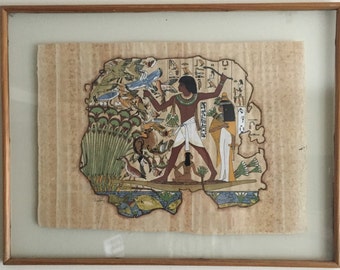

He is the one who can put you on watered land of Khepshyt. If you don't find (any) from him, you will have to go before Herunefer. Don't farm the land everyone else farms.You should ask from Hau Jr.
#Cairo papyrus museum full#
of land in full barley-in the land Khepshyt. Now, if it will be easy for you (all) to cultivate 2 dar. Should you have nothing more than that sheet I said to weave, they should take it valued from Sidder Grove and lease land for its value. If, however, they will have collected the equivalent value of that emmer that is (owed me) in Perhaa, they should use it there as well. They should take its lease from that sheet to be woven there (with you).

3-9 Arrange to have Heti's son Nakht and Sinebniut go down to Perhaa to cultivate for a dar. Mind you that my barley seed is guarded and that all my property is guarded. As for every part of our land that gets wet, you are the one who cultivates it-take heed-and all my people as well as you. 1-3 To be said by ka-servant Heqanakht to Merisu. 18-19 (Writing) that ka-servant Heqanakht sends to his household of Sidder Grove. To experts illuminate this artwork's story Link to a blog about scribes in Ancient Egypt Showing Signs: Hieroglyphs and Palettes in the Stela of Irtisen View more Listen He makes comments on the rental fee of land previously leased and gives directions about the rations to be provided for the man Nakht on his mission to Perhaa. In the letter Heqanakht gives instructions to send two individuals (Nakht, possibly Merisu's deputy, and Sinebniut, a subordinate) to rent land in a place named Perhaa. It is addressed to Heqanakht's family, specifically to a man called Merisu, who was a kind of steward responsible for the functioning of the household and its production. This is the front side (recto) of letter I, written, probably by Heqanakht himself, in columns from right to left on a pristine sheet of papyrus in hieratic script with black ink. The documents - some still folded, tied and sealed, when found - provide unique insights into the domestic and financial affairs of an average middle class family that lived almost four thousand years ago. Winlock in the excavation season of 1921-1922 in the tomb of Meseh, who had a side passage and crypt in the tomb complex of the vizier Ipy, one of the rock cut tombs along the cliff overlooking the temples at Deir el-Bahri.

The letters and accounts written by Heqanakht and one or more scribes on sheets of papyrus were discovered by Museum excavator Herbert E. As "ka-servant" of a high official he was responsible for the high official's statue cult and the administration of the land and income that had been endowed to maintain this cult. Heqanakht was a native of Thebes (present day Luxor) during the early twelfth dynasty.


 0 kommentar(er)
0 kommentar(er)
